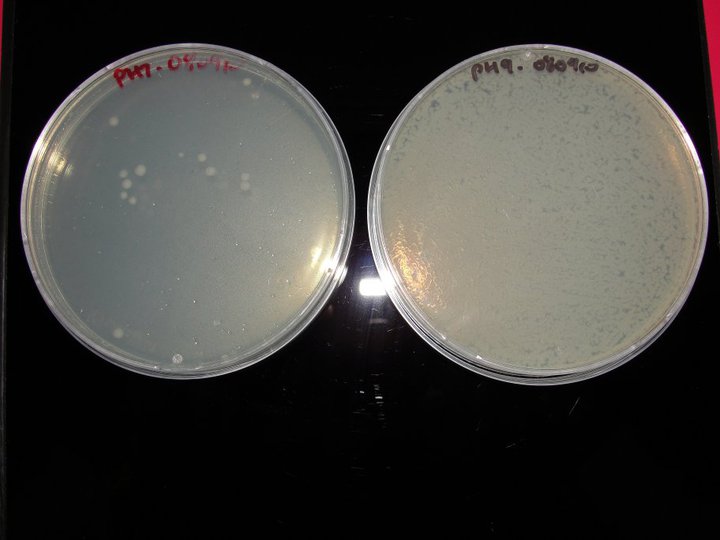Team:Newcastle/Alkalinity resistance
From 2010.igem.org
(Difference between revisions)
PhilipHall (Talk | contribs) (New page: Our chassis, ''Bacillus subtilis'' 168, can be acclimatised to the high pH of concrete (which can be as high as pH 10). Below on the left you can see ''Bacillus subtilis'' 168 which was gr...) |
PhilipHall (Talk | contribs) |
||
| Line 1: | Line 1: | ||
| + | {{Team:Newcastle/mainbanner}} | ||
| + | |||
| + | ===Alkalinity resistance=== | ||
| + | |||
Our chassis, ''Bacillus subtilis'' 168, can be acclimatised to the high pH of concrete (which can be as high as pH 10). Below on the left you can see ''Bacillus subtilis'' 168 which was grown under normal conditions (pH 7) and then transferred to pH 10. On the right is ''Bacillus subtilis'' 168 which has been acclimatised to high pH (by growing at increasing pH levels from 7 to 9) before being transferred to pH 10, and has a much higher rate of survival. | Our chassis, ''Bacillus subtilis'' 168, can be acclimatised to the high pH of concrete (which can be as high as pH 10). Below on the left you can see ''Bacillus subtilis'' 168 which was grown under normal conditions (pH 7) and then transferred to pH 10. On the right is ''Bacillus subtilis'' 168 which has been acclimatised to high pH (by growing at increasing pH levels from 7 to 9) before being transferred to pH 10, and has a much higher rate of survival. | ||
| Line 6: | Line 10: | ||
[[Image:Newcastle_pH_test.jpg]] | [[Image:Newcastle_pH_test.jpg]] | ||
| + | |||
| + | {{Team:Newcastle/footer}} | ||
Revision as of 02:19, 26 October 2010

| |||||||||||||
| |||||||||||||
Alkalinity resistance
Our chassis, Bacillus subtilis 168, can be acclimatised to the high pH of concrete (which can be as high as pH 10). Below on the left you can see Bacillus subtilis 168 which was grown under normal conditions (pH 7) and then transferred to pH 10. On the right is Bacillus subtilis 168 which has been acclimatised to high pH (by growing at increasing pH levels from 7 to 9) before being transferred to pH 10, and has a much higher rate of survival.
Results:(see below) Cells raised at pH 8 then moved to pH 10(left)did not survive as well as cells raised at pH 9 (right)
 
|
 "
"
